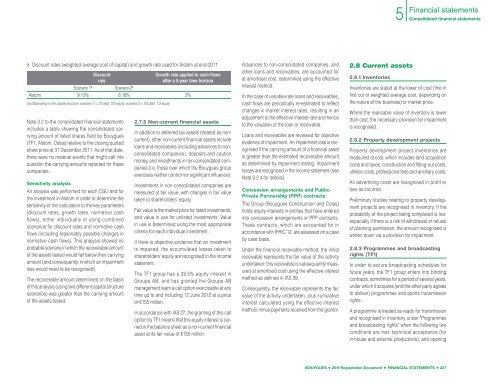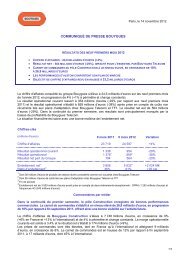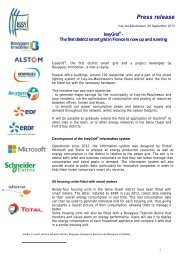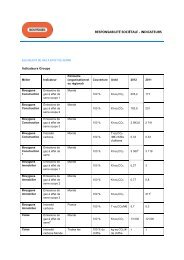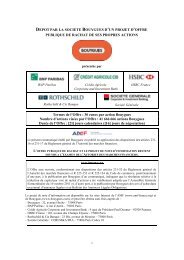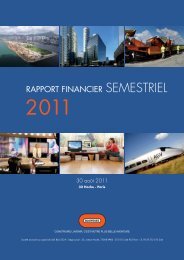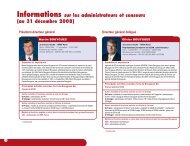Registration Document BOUYGUES
Registration Document BOUYGUES
Registration Document BOUYGUES
You also want an ePaper? Increase the reach of your titles
YUMPU automatically turns print PDFs into web optimized ePapers that Google loves.
5<br />
Financial statements<br />
Consolidated financial statements<br />
> Discount rates (weighted average cost of capital) and growth rate used for Alstom at end-2011<br />
Discount<br />
rate<br />
Scenario 1 a<br />
Growth rate applied to cash flows<br />
after a 5-year time horizon<br />
Scenario 2 a<br />
Alstom 9.12% 8.18% 2%<br />
(a) Depending on the capital structure: scenario 1 = 1/3 debt, 2/3 equity; scenario 2 = 2/3 debt, 1/3 equity<br />
Note 3.2 to the consolidated financial statements<br />
includes a table showing the consolidated carrying<br />
amount of listed shares held by Bouygues<br />
(TF1, Alstom, Colas) relative to the closing quoted<br />
share price at 31 December 2011. As of that date,<br />
there were no material events that might call into<br />
question the carrying amounts reported for these<br />
companies.<br />
Sensitivity analysis<br />
An analysis was performed for each CGU and for<br />
the investment in Alstom in order to determine the<br />
sensitivity of the calculation to the key parameters<br />
(discount rates, growth rates, normative cash<br />
flows), either individually or using combined<br />
scenarios for discount rates and normative cash<br />
flows (including reasonably possible changes in<br />
normative cash flows). This analysis showed no<br />
probable scenario in which the recoverable amount<br />
of the assets tested would fall below their carrying<br />
amount (and consequently, in which an impairment<br />
loss would need to be recognised).<br />
The recoverable amount determined on the basis<br />
of this analysis (using two different capital structure<br />
scenarios) was greater than the carrying amount<br />
of the assets tested.<br />
2.7.5 Non-current financial assets<br />
In addition to deferred tax assets (treated as noncurrent),<br />
other non-current financial assets include<br />
loans and receivables (including advances to nonconsolidated<br />
companies), deposits and caution<br />
money, and investments in non-consolidated companies<br />
(i.e. those over which the Bouygues group<br />
exercises neither control nor significant influence).<br />
Investments in non-consolidated companies are<br />
measured at fair value, with changes in fair value<br />
taken to shareholders’ equity.<br />
Fair value is the market price for listed investments,<br />
and value in use for unlisted investments. Value<br />
in use is determined using the most appropriate<br />
criteria for each individual investment.<br />
If there is objective evidence that an investment<br />
is impaired, the accumulated losses taken to<br />
shareholders’ equity are recognised in the income<br />
statement.<br />
The TF1 group has a 33.5% equity interest in<br />
Groupe AB, and has granted the Groupe AB<br />
management team a call option exercisable at any<br />
time up to and including 12 June 2012 at a price<br />
of €155 million.<br />
In accordance with IAS 27, the granting of this call<br />
option by TF1 means that this equity interest is carried<br />
in the balance sheet as a non-current financial<br />
asset at its fair value of €155 million.<br />
Advances to non-consolidated companies, and<br />
other loans and receivables, are accounted for<br />
at amortised cost, determined using the effective<br />
interest method.<br />
In the case of variable-rate loans and receivables,<br />
cash flows are periodically re-estimated to reflect<br />
changes in market interest rates, resulting in an<br />
adjustment to the effective interest rate and hence<br />
to the valuation of the loan or receivable.<br />
Loans and receivables are reviewed for objective<br />
evidence of impairment. An impairment loss is recognised<br />
if the carrying amount of a financial asset<br />
is greater than the estimated recoverable amount<br />
as determined by impairment testing. Impairment<br />
losses are recognised in the income statement (see<br />
Note 3.2.4 for details).<br />
Concession arrangements and Public-<br />
Private Partnership (PPP) contracts:<br />
The Group (Bouygues Construction and Colas)<br />
holds equity interests in entities that have entered<br />
into concession arrangements or PPP contracts.<br />
These contracts, which are accounted for in<br />
accordance with IFRIC 12, are assessed on a case<br />
by case basis.<br />
Under the financial receivable method, the initial<br />
receivable represents the fair value of the activity<br />
undertaken; this receivable is subsequently measured<br />
at amortised cost using the effective interest<br />
method as defined in IAS 39.<br />
Consequently, the receivable represents the fair<br />
value of the activity undertaken, plus cumulative<br />
interest calculated using the effective interest<br />
method, minus payments received from the grantor.<br />
2.8 Current assets<br />
2.8.1 Inventories<br />
Inventories are stated at the lower of cost (first in<br />
first out or weighted average cost, depending on<br />
the nature of the business) or market price.<br />
Where the realisable value of inventory is lower<br />
than cost, the necessary provision for impairment<br />
is recognised.<br />
2.8.2 Property development projects<br />
Property development project inventories are<br />
measured at cost, which includes land acquisition<br />
costs and taxes, construction and fitting-out costs,<br />
utilities costs, professional fees and ancillary costs.<br />
All advertising costs are recognised in profit or<br />
loss as incurred.<br />
Preliminary studies relating to property development<br />
projects are recognised in inventory. If the<br />
probability of the project being completed is low,<br />
especially if there is a risk of withdrawal or refusal<br />
of planning permission, the amount recognised is<br />
written down via a provision for impairment.<br />
2.8.3 Programmes and broadcasting<br />
rights (TF1)<br />
In order to secure broadcasting schedules for<br />
future years, the TF1 group enters into binding<br />
contracts, sometimes for a period of several years,<br />
under which it acquires (and the other party agrees<br />
to deliver) programmes and sports transmission<br />
rights.<br />
A programme is treated as ready for transmission<br />
and recognised in inventory under "Programmes<br />
and broadcasting rights" when the following two<br />
conditions are met: technical acceptance (for<br />
in-house and external productions), and opening<br />
<strong>BOUYGUES</strong> • 2011 <strong>Registration</strong> <strong>Document</strong> • FINANCIAL STATEMENTS • 227


